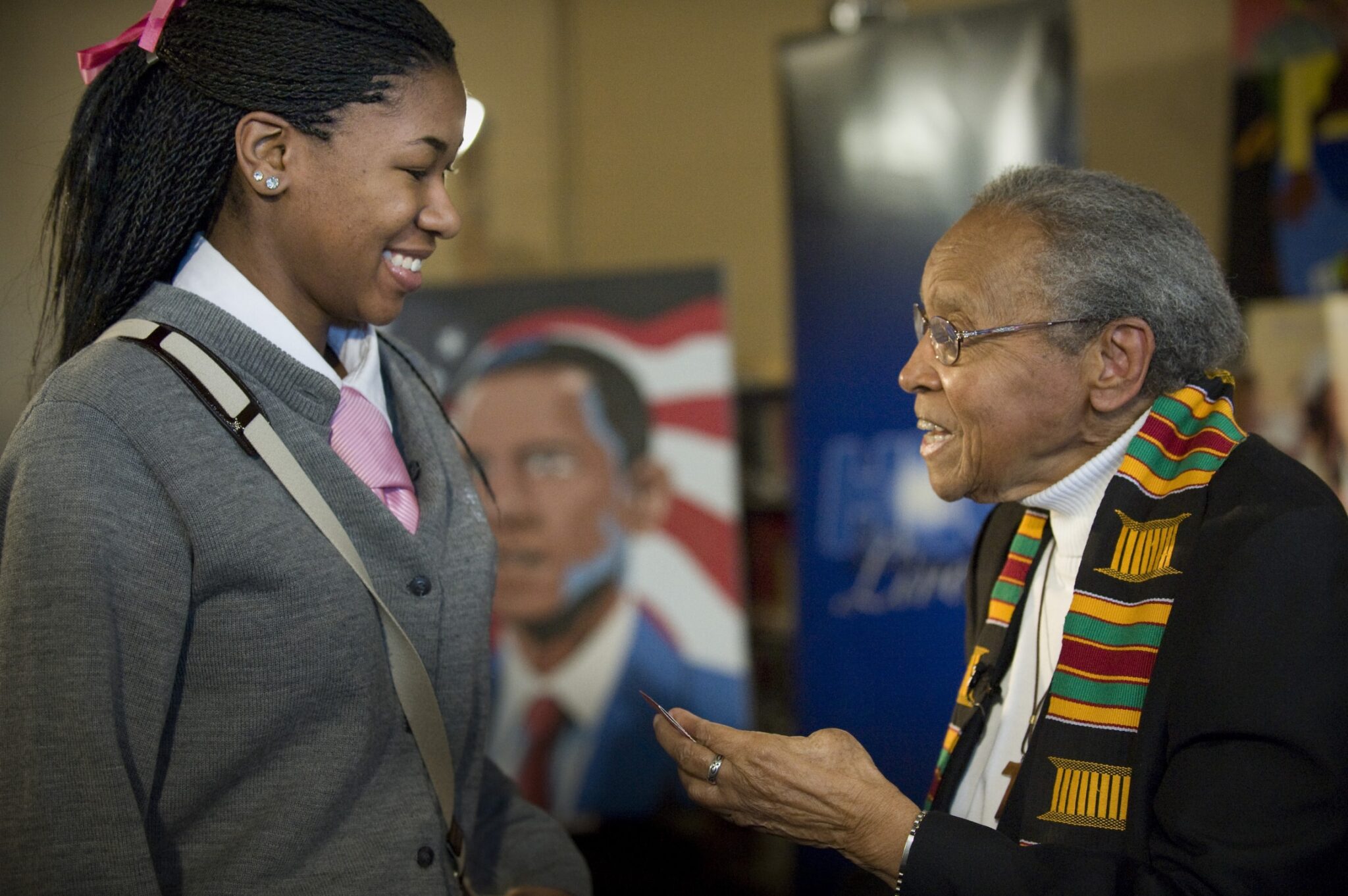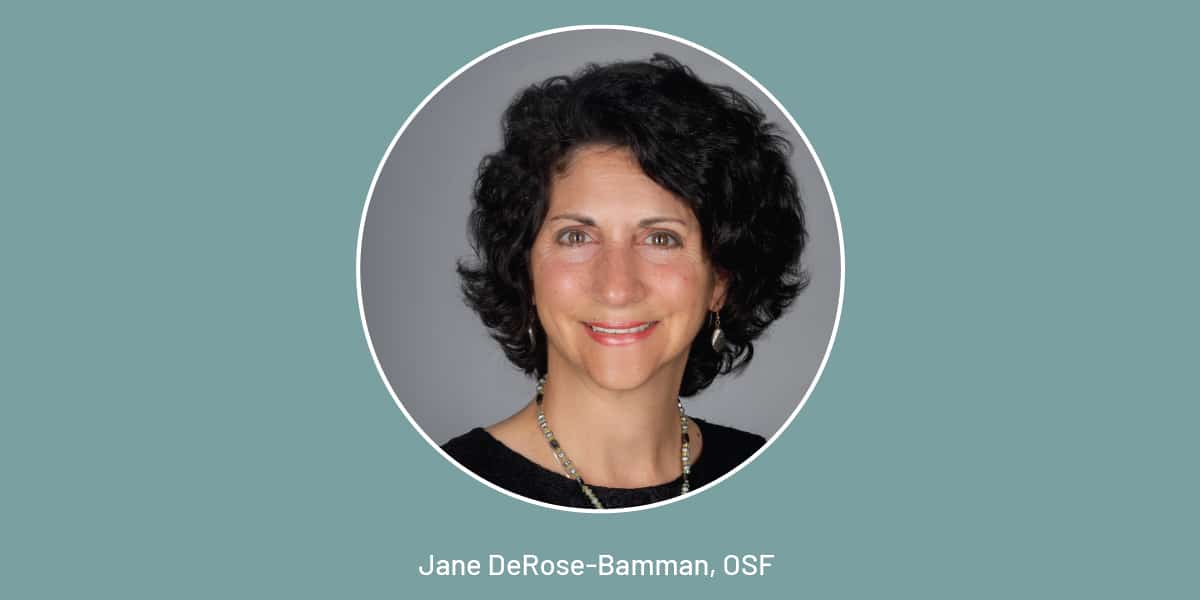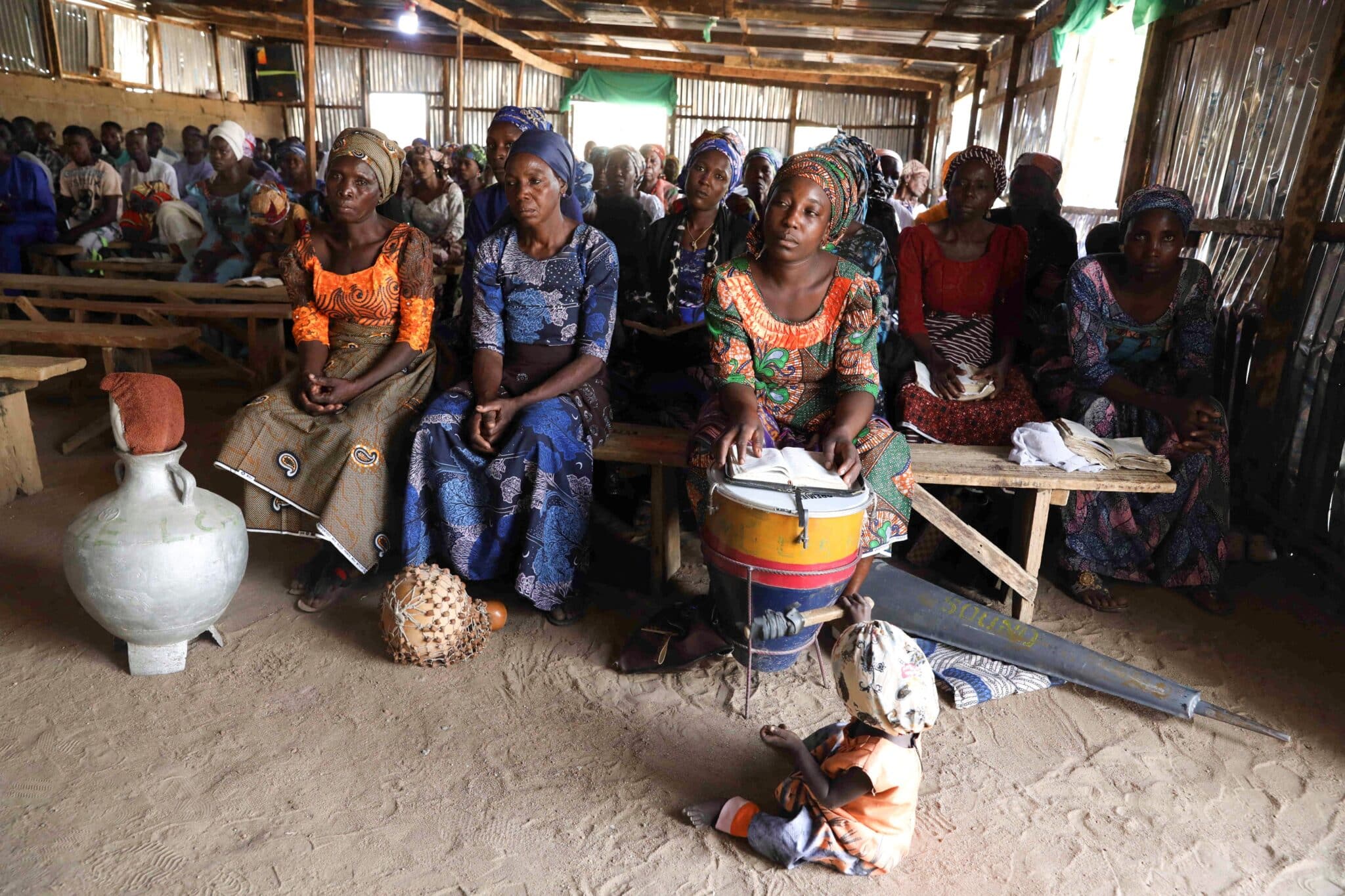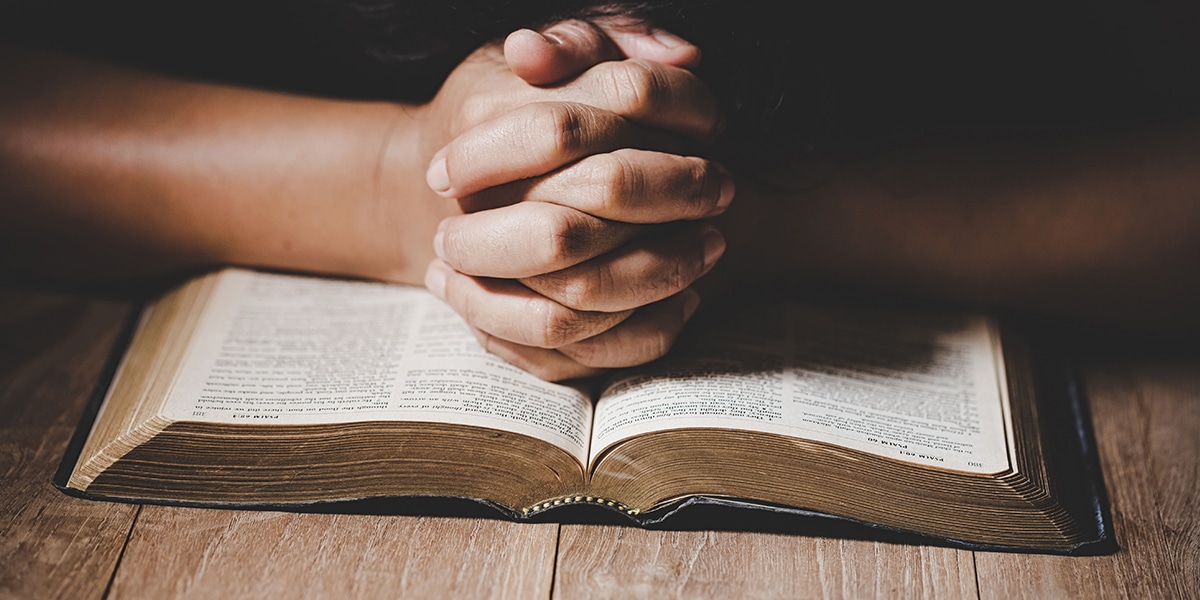During the past few weeks Sister Antona Ebo, a Franciscan Sister of Mary, has been making national news again. She and a number of Catholic sisters were pioneers in the struggle for civil rights in Selma, Alabama, back in 1965.
Now a PBS documentary, Sisters of Selma: Bearing Witness for Change, is telling their story, 42 years later. The film, produced and directed by Los Angeles filmmaker Jayasri Majumdar Hart, is a look at the events that led to the protest. Along the way, it sets the context of Church renewal that led the sisters to take a controversial, public stand for civil rights.
Six sisters were part of the St. Louis delegation to Selma on Wednesday, March 10, 1965. It was three days after a peaceful protest march had been brutally attacked by white-supremacist local authorities, a shocking, widely publicized event that caused the day to be forever known as “Bloody Sunday. ” The sisters’ appearance among the protesters in the following days and especially African-American Sister Antona made worldwide headlines.
St. Anthony Messenger caught up with this amazing 82-year-old at the world premiere of the film at the University of Dayton late in 2006. We spent some time with Sister Antona and producer Jayasri Hart. Here is the remarkable story of the woman who, when it was time to “put up or shut up, ” as Sister Antona says, flew on what she calls “a rickety plane ” to Selma.
Introducing Sister Antona
The civil-rights struggle in Selma, Alabama, seems like ancient history to young people today. The Sisters of Selma film premiere at a University of Dayton auditorium drew a standing-room-only crowd of theology-class students at the Marianist university, most of whom though attendance was mandatory seemed fascinated by this old woman before them who had actually played a hand in history.
“They said they read about all this stuff, ” says Sister Antona, speaking of one of her many college audiences, “but they really didn’t know anybody that really could tell them about the story. ” One of her young friends back home in St. Louis, Missouri, calls her “Grandma Sister, ” she quips. “I love to hear that. ”
This now-grandmotherly Franciscan Sister of Mary was 41, working at a hospital in St. Louis, where the community is based, when the Selma protest happened. What brought her to the Franciscan sisters is a story in itself, one that helps explain how she wound up in Selma. She tells her story not without humor.
Elizabeth Louise Ebo became Sister Mary Antona in 1947 a year after she entered the convent. She took the name Antona from a Sinsinawa Dominican sister who had taught her algebra and geometry. “When I got finished with her, she gave up teaching and went to a cloister out in California! ” she says with a mischievous grin, and adds that another of her teachers followed to the cloister soon thereafter (they were starting a new foundation).
She credits her conversion to Catholicism as a young girl to a dare from a friend and the presence of the Blessed Sacrament. Her mother had died when Elizabeth was only four, and the Great Depression had left her illiterate father unable to support his three children. So the three siblings grew up in McLean County Home for Colored Children, in their hometown of Bloomington, Illinois. When she was about nine, one of her childhood friends, Bish ( “he was nicknamed Bishop because he wore his beads around his neck and told me that that was his rosary, ” she explains), convinced her to go with him inside St. Mary’s Church (staffed by Franciscan friars of St. John the Baptist Province).
The young girl was fascinated and felt drawn to the Blessed Sacrament. Little could she imagine that, decades later, she would receive Communion directly from Pope John Paul II, during his 1999 visit to St. Louis. That’s getting ahead of the story, but it shows what a gift her friend Bish was in her life. While she was waiting to receive Communion from the pope, she says, “I could only think,Bish brought me to this. ”
She recalls of the distant past, “When Bish and I were sent downtown to pick up the day-old bread from the bakery, on the way Bish said to me: ‘If I go in that church, will you tell on me?’ And I said, ‘No.’ Honey, and I went in that church! Bish went straight up to the Communion rail, knelt down and prayed.
“Then we had to run all the way to the bakery and run all the way back, but meanwhile, he’s huffing and puffing and telling me why he was kneeling before that altar. ” She looked later in her “Baptist Bible ” and read the words of Jesus offering his body and blood as real food and real drink. “As an adult, ” she says, “as I reflect on that story, I think we were on the way to pick up day-old bread for our body. And this child taught me about the bread of life that was on that altar. ”
A few years after that, young Elizabeth contracted tuberculosis and her thumb became badly infected. “I lost the thumb and got religion, ” she quips, because while she was isolated in the TB sanatorium, she took classes and ultimately became Catholic. Her love of the Eucharist and her desire to work as a nurse led her away from Bloomington to a segregated St. Louis convent, one of the few that would accept blacks. “We have a song that says, ‘He’s preparing me for everything that comes in my life’ and he prepared me. ”
A Selma Sister
Nearly 20 years later as a sister, a Medical Record Administrator, and an assistant hospital administrator, it became clear that her preparations had other purposes, too.
It was March 7, 1965. The Southern Christian Leadership Conference, led by Dr. Martin Luther King, Jr., had been invited to Selma, Alabama, by the local black community and members of the Student Nonviolent Coordinating Committee (SNCC). Selma, seat of Dallas County, became the focus for civil-rights protests that year (though there were various actions across the South). Dallas County was in the heart of Alabama’s “black belt ” of former plantation communities (named for both its rich soil and its consequent majority black population). It had been home to a rash of lynchings at the turn of the 20th century.
Racial oppression had settled into what was called “Jim Crow ” (similar to South Africa’s apartheid). Police brutality, public-building designations of “colored ” and “white ” sections, voter registration all of these became justice targets of the “Dallas County Improvement Association, ” a civil-rights group formed in 1963.
At an impromptu march in nearby Marion in late February 1965, protester Jimmie Lee Jackson had been killed. He was seeking shelter for his mother from the violence after a 200-man-strong phalanx of local and state police, along with local vigilantes, attacked the marchers. The Southern Christian Leadership Conference (SCLC), headed by Dr. King, called for a peaceful protest march on Sunday, March 7, from Selma to Montgomery to draw attention to what was happening.
That “Bloody Sunday ” march was attacked by the same police and vigilantes who had stopped the Marion protest. One vocal white-supremacist leader was Sheriff Jim Clark, openly backed by Alabama Governor George C. Wallace. The relatively new medium of TV, as well as newspapers, brought vivid images from Bloody Sunday across the world. Peaceful marchers were clubbed, beaten, bitten by police dogs and horsewhipped by Sheriff Clark and his horse-mounted posse.
Much of the nation including members of Congress was horrified. The Sisters of St. Joseph of Rochester (New York) who, along with the Edmundites, operated Good Samaritan Hospital, the only hospital in Selma that would treat blacks, cared for the injured.
Dr. King’s SCLC and other groups put out an appeal for religious leaders everywhere to come to Selma. They came for a march Tuesday, but didn’t get far. When a court order prohibiting local interference was obtained in the coming days, the historic march finally was completed, all the way to Montgomery, 54 miles east along Highway 80. Montgomery is where the bus boycott had launched the civil-rights struggle 10 years earlier. After Governor Wallace refused to provide protection, President Johnson federalized the Alabama National Guard and assigned them the closely supervised task.
History, then, rightly considers the Selma Voting Rights March as taking place over several weeks, March 7-25. The nation closely watched the whole event. Although she was only there for the March 10 protest, Sister Antona and the religious leaders who came that day played an especially important role, quickly expressing the nation’s moral outrage. That public support eventually persuaded President Johnson to intervene and ensure the marchers’ safety.
‘Are You Outta Your Mind?’
“I wound up in Selma because my employees came in on Monday morning and told me what had happened on Sunday afternoon, ” Sister Antona recalls. “God called my bluff. ” Sister Antona had been commenting that if she didn’t have so many responsibilities she would be “down there with those people. ” That was Tuesday afternoon. “On Tuesday evening I get a call from Sister Eugene Marie (superior and the administrator of the hospital I was one of her assistants). I was trying to finish some copy work and she said, “How would you like to go to Selma tomorrow? ” Then she said, ‘Are you still there?’ ”
Selma was the water cooler/dinner table topic on Americans’ minds everywhere in the days after Bloody Sunday. Word of her pending trip swept through the hospital and a friend called her, offering advice. “Now, Sister, if you go down there, you don’t know the deep South. Stay with the group and keep your mouth shut. ” Then she heard on the news that night that a protester, Rev. James Reeb, from Boston, had been beaten to death. “And I’m thinking to myself, Are you outta your mind? ”
There were no other black women going from St. Louis she knew she would be alone in that sense. But Cardinal Joseph Ritter and her superior had come up with the plan. They chartered two small planes (that had been “mothballed, ” she remembers, speaking of their poor condition) and the St. Louis contingent of sisters went to Selma. “That’s when it hit me, when we got off of that plane. ” She thought, “I hope you realize that, no matter how you try to stay with the group, if you get arrested, you ain’t gonna be with the group of sisters. ”
But basically, she says, people worried more at home than she did in Selma. “They had time to think about that. I really didn’t think that much about it. ” Another moment of truth came for her that day when a federal agent advised her to take off her glasses if she could see well enough without them: “That was when I came through with that silly thought, Oh, God, this is going to be real trouble. We’re not down here to play pick-up-sticks. I don’t know why I thought of pick-up-sticks, except maybe somebody might have been ready to pick us up after everything was over! ”
Her presence, along with that of the other sisters, was deeply encouraging to the marchers. Andrew Young, a civil-rights leader who would one day be famous in public service, told the marchers upon the sisters’ arrival at the staging spot of Brown A.M.E. Chapel, in Selma, “Ladies and gentlemen, one of the great moral forces of the world has just walked in the door. ”
The march went only a few blocks that day, but the photographs of the marchers went everywhere. Sister Antona, who had been put at the front of the line because of her dark skin and religious habit, found herself, among the other five sisters, on the front page of The New York Times, telling reporters that she was proud to be black: “I’m here because I’m a Negro, a nun, a Catholic, and because I want to bear witness. ”
One highlight of the event for her was at Brown Chapel, when a young black girl ran up and embraced her. “She said she knew sisters, but never had seen one like herself. ” That was blessing enough for Sister Antona: “There are times when you know God is in charge. ”
By 4 p.m., the sisters were back on their planes to St. Louis. Finally, on March 21, the marchers in Selma left for Montgomery and were protected all the way by the U.S. government. At the end of the four-day march, Dr. King’s famous words rang out to the crowd of 25,000: “I know you are asking today, ‘How long will it take?’â¦Not long, because the arm of the moral universe is long, but it bends toward justice. ”
As it turned out, it took only a few months from that famous speech for the National Voting Rights Act of 1965 to become law, but everyone knows it was only one of many parts of the civil-rights struggle. That very year of 1965 saw the assassination of Malcolm X, the Watts riots in Los Angeles and the first affirmative-action ruling, in addition to the Voting Rights Act.
From the Brown v. Board of Education Supreme Court ruling in 1954 until the assassination of Dr. King in 1968, then the school-busing conflicts of the 1970s and ’80s, and beyond, the road has been riddled with struggle, with victory combined with disappointment. “How long? ” has been very long, for those committed to racial justice.
In 1967 she became the first black woman religious to run a hospital (St. Clare Hospital in Baraboo, Wisconsin). Sister Antona went on, in 1968, to be a founder of the National Black Sisters’ Conference, and later served as its president. With a master’s degree from Aquinas Institute of Theology, she spent six years, in the 1980s, working as a chaplain at the University of Mississippi Medical Center.
Eventually, Sister Antona moved back to St. Louis to serve as a Councilor leader of her community. The State of Alabama, in 2000, awarded her a state senate commendation for her civil-rights work.
Enter the Filmmaker
It was not long after that Los Angeles filmmaker Jayasri Hart came upon the story. Jayasri is a Calcuttan Hindu who, as a young girl, had worked with Blessed Mother Teresa: “Mother Teresa was just starting out and she had very little help, ” she explains. “So she enlisted local schools to help out to send volunteers. ” Jayasri came to the University of Southern California to study filmmaking, and wound up married and living in Los Angeles. She had an interest in what makes women religious tick.
She and her partners were doing research about the Catholic Church during the 1960s, looking for a good story of how the changes from Vatican II had blossomed into a new space for women religious. Then Hart came across the story of the Selma sisters.
She had been looking for a good story to tell, and here it was: “It captured my imagination. Here you have the intersection of feminist issues, civil-rights issues, race issues and religious issues. ”
There are six featured sisters of Selma, but Jayasri sees Sister Antona as the “star ” of her film: “As she [Sister Antona] says, suddenly it became important that she was black. I think that mobilized the whole story. ”
It took five years to bring the film to completion, including long hours researching film archives of the civil-rights movement, and locating funders far and wide, including the U.S. bishops’ Catholic Communication Campaign. Along the way Jayasri gained new insights into the relationship between Christian pacifism, especially as lived by Dr. Martin Luther King, Jr., and Mahatma Gandhi’s pacifism that she knew so well from home. (Gandhi had a profound influence on Dr. King’s thinking.) And she also learned that sisters of color, like Sister Antona, endured a history of segregation within the Church. But that’s a story for another day.
Making the film, Jayasri became close friends with Sister Antona who, in a clever play on her Indian name, calls her “Re-Joyce. ”
Sister Antona brings her sense of joy and her wit to the task of promoting mutuality in mission among people of all races in the work of the Church. She, along with civil-rights pioneer Rosa Parks (who sat in the front of the Montgomery bus in 1955) was singled out in 1999 to receive the Eucharist from Pope John Paul II. But Sister Antona, too, credits her inspiration to Dr. Martin Luther King, Jr., who asked so many years ago, like the psalmist, “How long? ” She herself, now in her ninth decade, wonders how long.
“Martin shared that dream with the multitude, ” recalls Sister Antona. “So if that was true, then what have we been doing all these years? ” She recalls that Dr. King wrote to ministers from the city jail in Birmingham, “We are always being told to wait. And now we have waited far too long. ” When she talks to students and Church groups which even at her ripe age she does frequently she returns to “When are we going to have our own dreamers? ” And, usually, by the third time she says it, the students or Church members understand what she seeks. They reply, “We have waited far too long. ”








